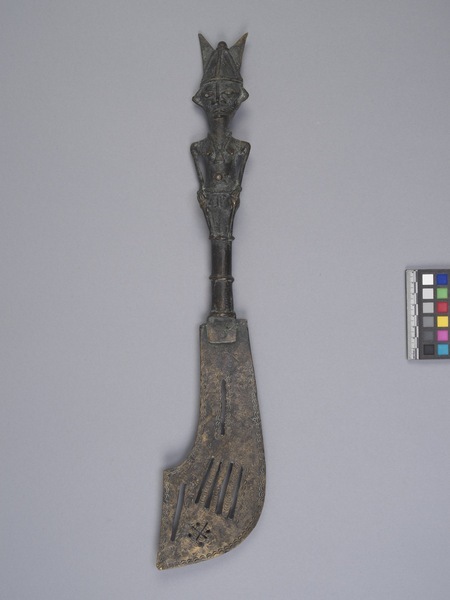Sword Item Number: 3326/48 from the MOA: University of British Columbia


Description
Small sword. The curved blade is decorated with six cutout lines and an X design with a dot in each angle. Two rows of small hammered curved lines outline the edge of the blade and around each cutout. The handle depicts a seated female with hands on knees. She wears a tall pointed headdress with two smaller ear-like points extending out. She has small pointed breasts, a large protruding naval, wears a large necklace with triangular pendant, and has a band around her waist, which repeats down the handle three more times. Her cheeks are marked with lines representing scarification(?).
History Of Use
These swords, with their distinctive J-shaped blades and anthropomorphic hilts, were usually ceremonial, used in spiritual practices or as a symbol of social status. This sword potentially belonged to a member of the Ogboni Society. The Ogboni Society is a fraternal institution in Yoruba-speaking communities in Nigeria. Members of this organization have historically had significant political influence and served in judicial courts. If this sword belonged to a member of the Ogboni Society, it could have possessed additional ceremonial significance due to the social status of its bearer.
Narrative
Assumed to have been collected by Lieber while he was living in Nigeria (1965-1970), lecturing at the University of Ibadan under the auspices of CIDA.
Iconographic Meaning
The lines on the female figure's face potentially represent Yoruba ritual scarification. The shape of the blade is also associated with the spirit Ogun in Yoruba tradition, a spiritual figure associated with metalworking.
Item History
- Made in Nigeria
- Collected between 1965 and 1970
- Owned by Jack Lieber before 2015
- Owned by Iris Lieber before June 18, 2018
- Received from Iris Lieber (Donor) on June 18, 2018
What
- Name
- Sword
- Identification Number
- 3326/48
- Type of Item
- sword
- Material
- bronze metal ?
- Overall
- height 49.0 cm, width 9.3 cm, depth 2.7 cm
Who
- Culture
- Yoruba ?
- Previous Owner
- Jack Lieber and Iris Lieber
- Received from
- Iris Lieber (Donor)
Where
- Holding Institution
- MOA: University of British Columbia
- Made in
- Nigeria
When
- Collection Date
- between 1965 and 1970
- Ownership Date
- before 2015 and before June 18, 2018
- Acquisition Date
- on June 18, 2018
Other
- Condition
- fair
- Accession Number
- 3326/0048